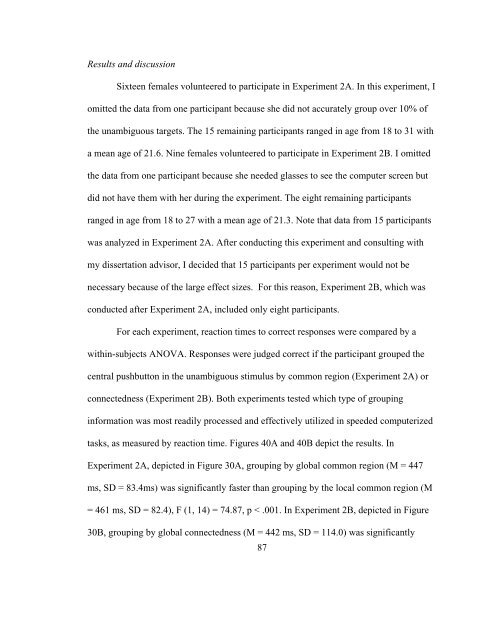The Use of Iambic Pentameter in the
The Use of Iambic Pentameter in the
The Use of Iambic Pentameter in the
Create successful ePaper yourself
Turn your PDF publications into a flip-book with our unique Google optimized e-Paper software.
Results and discussion<br />
Sixteen females volunteered to participate <strong>in</strong> Experiment 2A. In this experiment, I<br />
omitted <strong>the</strong> data from one participant because she did not accurately group over 10% <strong>of</strong><br />
<strong>the</strong> unambiguous targets. <strong>The</strong> 15 rema<strong>in</strong><strong>in</strong>g participants ranged <strong>in</strong> age from 18 to 31 with<br />
a mean age <strong>of</strong> 21.6. N<strong>in</strong>e females volunteered to participate <strong>in</strong> Experiment 2B. I omitted<br />
<strong>the</strong> data from one participant because she needed glasses to see <strong>the</strong> computer screen but<br />
did not have <strong>the</strong>m with her dur<strong>in</strong>g <strong>the</strong> experiment. <strong>The</strong> eight rema<strong>in</strong><strong>in</strong>g participants<br />
ranged <strong>in</strong> age from 18 to 27 with a mean age <strong>of</strong> 21.3. Note that data from 15 participants<br />
was analyzed <strong>in</strong> Experiment 2A. After conduct<strong>in</strong>g this experiment and consult<strong>in</strong>g with<br />
my dissertation advisor, I decided that 15 participants per experiment would not be<br />
necessary because <strong>of</strong> <strong>the</strong> large effect sizes. For this reason, Experiment 2B, which was<br />
conducted after Experiment 2A, <strong>in</strong>cluded only eight participants.<br />
For each experiment, reaction times to correct responses were compared by a<br />
with<strong>in</strong>-subjects ANOVA. Responses were judged correct if <strong>the</strong> participant grouped <strong>the</strong><br />
central pushbutton <strong>in</strong> <strong>the</strong> unambiguous stimulus by common region (Experiment 2A) or<br />
connectedness (Experiment 2B). Both experiments tested which type <strong>of</strong> group<strong>in</strong>g<br />
<strong>in</strong>formation was most readily processed and effectively utilized <strong>in</strong> speeded computerized<br />
tasks, as measured by reaction time. Figures 40A and 40B depict <strong>the</strong> results. In<br />
Experiment 2A, depicted <strong>in</strong> Figure 30A, group<strong>in</strong>g by global common region (M = 447<br />
ms, SD = 83.4ms) was significantly faster than group<strong>in</strong>g by <strong>the</strong> local common region (M<br />
= 461 ms, SD = 82.4), F (1, 14) = 74.87, p < .001. In Experiment 2B, depicted <strong>in</strong> Figure<br />
30B, group<strong>in</strong>g by global connectedness (M = 442 ms, SD = 114.0) was significantly<br />
87

















